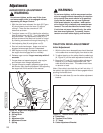
19
Operation
AFTER EACH USE
Normal use of the snowthrower may result in a build-
up of packed snow in and around the starter cord
housing and around engine controls. Heat from the
engine will usually prevent the snow from freezing
solid while the unit is running, but after the engine is
shut down, some snow may continue melting from
engine heat, and later freeze around some moving
parts as the unit cools.
After each period of use, follow these steps to prevent
freeze-up caused by ice formation in and around the
engine controls and external parts.
1. Before shutting off the engine, pull the starter rope
out 2 - 3 times, and allow it to rewind slowly. This
will help clear packed snow from the starter cord
area. Allow the engine to run for several minutes.
2. Stop the engine by pushing the stop switch (C,
Figure 2) to the off position then pull out the
engine key (D, Figure 2).
3. Brush snow and ice from the snowthrower. Be
sure to clear engine and snowthrower controls,
discharge chute, and chute rod gears, clutch cable
areas, and anywhere else snow has accumulated.
4. Always remove the engine key and store in a safe
place to prevent unauthorized use.
5. If the snowthrower is kept in a cold shelter, fill the
fuel tank to prevent condensation. Do not store
near sparks or flame.
Note: The Engine Owner’s Manual contains further
information on preventing ice formation and freeze-up.
WARNING
Never store the unit (with fuel) in an enclosed,
poorly ventilated structure. Fuel vapors can
travel to an ignition source (such as a furnace,
water heater, etc.) and cause an explosion.
Fuel vapor is also toxic to humans and
animals.
WARNING
Never store the unit, with gasoline in engine or
fuel tank, in a heated shelter or in enclosed,
poorly ventilated enclosures. Gasoline fumes
may reach an open flame, spark or pilot light
(such as a furnace, water heater, clothes dryer,
etc.) and cause an explosion.
Handle gasoline carefully. It is highly
flammable and careless use could result in
serious fire damage to your person or property.
Drain fuel into an approved container outdoors
away from open flame or sparks.
STORAGE
Before you store your unit for the off-season, read the
Maintenance and Storage instructions in the Safety
Rules section, then perform the following steps:
• Perform engine maintenance and storage
measures listed in the engine owner’s manual.
This includes draining the fuel system, or adding
stabilizer to the fuel (do not store a fueled unit in
an enclosed structure - see warning).
Before starting the unit after it has been stored:
• Check all fluid levels. Check all maintenance
items.
• Perform all recommended checks and procedures
found in the engine owner’s manual.
• Allow the engine to warm up for several minutes
before use.
WARNING
Never store the unit (with fuel) in an enclosed,
poorly ventilated structure. Fuel vapors can
travel to an ignition source (such as a furnace,
water heater, etc.) and cause an explosion.
Fuel vapor is also toxic to humans and
animals.
Operation
CLEARING A CLOGGED
DISCHARGE CHUTE
Hand contact with the rotating auger/impeller inside
the discharge chute is the most common cause of
injury associated with snowthrowers. DO NOT use
your hand to clean out the discharge chute. To clear
the chute:
1. Stop the engine. Remove the key
2. Wait 10 seconds to be sure the auger/impeller
blades have stopped rotating.
3. Use the clean-out tool to remove clogs. DO NOT
use your hands.





















